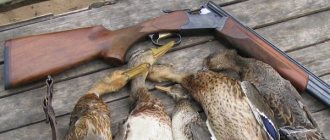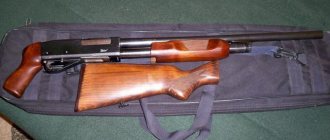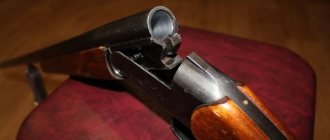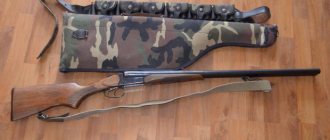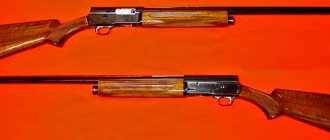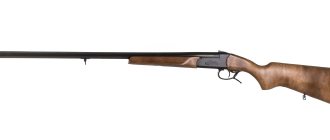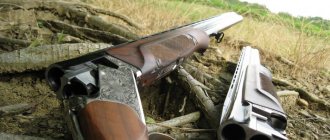The history of the Browning 525 shotgun begins in the 20th century with the appearance on the market of the first high-quality and affordable over-and-under. Its designer was John Moses Browning, an outstanding gunsmith who made a tremendous breakthrough in the development of hunting weapons. The brilliant inventor began work on his first model of a side-flip gun called “Superposed” in the 30s, when many people used guns only with horizontal barrels. John Browning patented the model, but died before it went into mass production. Sales started in 1928. His development was accepted as a novelty: although such a design was known, it was not widespread. Only a few manufacturers in England produced vertical guns, and the cost made such weapons a luxury.
“Superposed” immediately attracted hunters. Other manufacturers, realizing that over-and-under shotguns were gaining popularity, began creating their own models. So “verticals” ceased to be considered exotic. The Browning company continued to improve guns after the death of its founder. Now the Browning 525 – the fifth generation model – is considered a very high-quality “vertical” in all respects.
Browning 525
Description
Browning B525 is a smooth-bore hunting rifle, suitable for almost all types of classic hunting (the manufacturer leaves the opportunity to select different choke constrictions). The Browning B525 can easily be classified as a luxury firearm due to its design, hand-fitting and high quality materials used in its creation. Browning B525 receives virtually no criticism. Its design successfully emphasizes all the advantages of sideflint. Reliability, practicality and affordability make this model popular among many shooters.
The gun comes in a plastic case
There are lines of hunting and sporting rifles. Hunting rifles (Hunter) exist in four variations: Classic, Elite, Prestige and Heritage. The Hunter Light modification (Classic, Elite) is intended for walking hunting: it has less weight. Shotguns with the inscription LH (left-hand) are needed so that left-handers do not feel discomfort when using weapons. The sports line includes the following models: Sport, Sport Premium Gold, Sport Elite, Sport Prestige and Sport Heritage.
History of creation
The history of the Browning 525 hunting rifle begins in the 20th century with the appearance on the market of the first high-quality and affordable vertical rifle. Its designer was John Moses Browning, an outstanding gunsmith who made a tremendous breakthrough in the development of hunting weapons. The inventor began work on his first model of a side-flip gun, called Superposed, in the 30s, when many people used guns only with horizontal barrels.
John Browning patented the model, but died before it went into mass production. Sales started in 1928. His development was accepted as a novelty; although such a design was known, it was not widespread. Only a few manufacturers in England produced over-and-unders, and the cost made such weapons a luxury.
The new Browning Superposed immediately attracted the attention of hunters, initially American. Other manufacturers, seeing the growing popularity of hunting rifles with a similar barrel arrangement, began to develop their own models, no longer considering them exotic. Remington released its Model 32 in 1932, Marlin introduced its Model 90 in 1937, and Savage did not develop the Model 420 for the North American market until 10 years after the Superposed's triumph.
The Browning company continued to improve guns after the death of its founder. Now the Browning 525 - the fifth generation model - is considered a very high-quality vertical in all respects.
Peculiarities
Browning has the following features: Hunting-themed engraving on the receiver is a signature feature of the Browning company. Its complexity depends on the cost of the gun purchased by the buyer. The barrels are equipped with Magnum chambers for the possibility of using cartridges with a powerful charge. This ensures effective target destruction at long distances. The browning b525 shotgun is equipped with a Back-Bored drill, which became a real technological breakthrough in 1990. Due to the larger bore diameter (18.8 mm instead of the traditional 18.5 mm), the designers managed to reduce the abrasion of the shot shell on the barrel walls, prevent its deformation, and also increase the speed, sharpness and accuracy of the projectile.
Manufactured by Browning, the Invector Standard and Invector Plus barrels are marked STEEL SHOT, which means they are suitable for use with steel shot, which is effective for short-range shooting.
Browning: the standard of quality
PHOTO BY BROWNING COMPANY
John Browning left a deep mark on the development of both civilian and military small arms, and, unusually, the designer practically did not borrow from other developers: his designs are original, and his solutions are technically ingenious and impeccable.
Many of them have become classics and are still used and borrowed today. Some weapon models, after more than a hundred years, have not lost their relevance and are mass-produced with minimal changes.
At the age of 23, John Browning came up with and patented his first invention. Over the 71 years of his life, the master created 37 models of rifled and 18 smooth-bore weapons, including the legendary Browning A5 and B25.
In this article we will focus on a gun that became a classic thanks to Browning. This is a double-barreled over/under B25.
The very first 12-gauge Browning B25 with a block of vertically arranged barrels and a steel block was released in 1928. It became the first mass-produced over/under, available to most hunters and sportsmen.
For developers of weapon systems, the Browning B25 is still considered the reference model and the basis for numerous copies, clones and variations.
The gun was so successful that the company even released a version in a different caliber only two decades later. The 20-gauge B25 modification went on sale only in 1949.
| PHOTO GABY53MT/FLICKR.COM (CC BY-ND 2.0) |
Today, the vertical position is familiar to us, but at the beginning of the 20th century, a gun with such an arrangement of barrels looked unusual and, one might say, even revolutionary.
Everyone is accustomed to the classic forms: only horizontal arrangement, and nothing else. Vertical trunks have a number of advantages. They have a larger viewing angle, are maneuverable, and have good balance. Vertical barrels practically do not “baptize”.
Their recoil axis runs in the same plane as the butt, and therefore the recoil of the weapon is less in the horizontal plane when fired. Many people like the appearance of such weapons. But it also has some disadvantages.
Thus, the block of vertical guns is more massive, and the opening angle of the barrels is greater than that of horizontal guns. Some experts believe that horizontal locking is more reliable.
Of course, all the pros and cons were played out to the fullest by advertisers and marketers. And, as usually happens, verticals have ardent fans and opponents.
But the Browning B25 shotgun stands apart from these debates; it has practically no critics. Browning managed to create a design that minimized the disadvantages and enhanced the advantages of a gun with vertically positioned barrels.
Impeccable appearance, elegant shape and, of course, technical perfection made this weapon desirable and prestigious. Like most of the guns that Browning designed, the B25 was intended for a wide range of shooters.
Its main components are simplicity of design, reliability and relatively low price.
| The gun can be equipped with one or several pairs of barrels. |
The heart of the B25 shotgun is the block. Since the over/under is fundamentally different from the classic side-by-side shotgun, Browning had to design the block almost from scratch.
It is made from a single piece of metal and has a rectangular shape. In the front there is a small semicircular protrusion by which the B25 model can be recognized in any circumstances. The block contains the trigger and the locking mechanism.
The hammers and firing pins are separated, the mainsprings are spiral, which was rare for that time: usually leaf springs were used, but twisted, much more technologically advanced and simpler, which ultimately influenced the final price of the product.
The hammers are cocked when the barrels are broken. In the traditional version, the gun comes with one trigger, the order of shots changes.
One of the biggest challenges was developing a secure lock. There are two hooks on the barrel block. At the first, the block rotates around an axis passing through the block.
The axle has an increased diameter, which makes the contact area noticeably larger and thereby enhances the reliability of the structure.
The enlarged axis increases the survivability of the gun and allows you to achieve large shots without the appearance of shatter. The second hook fits into a special cutout in the block, and thus the barrel block is fixed in the block; When closing the gun, a massive plate fits into a special cutout on the barrel block and locks them.
To release the block, you need to turn the key located on the top of the box. Despite the absence of any other stops, the system proves to be reliable and durable.
| A variant of the gun, richly decorated with engraving. PHOTO BY BROWNING COMPANY |
The trunks are soldered along the entire length; a tapered sighting strip is soldered to the top one. The handguard is attached to the barrel block from below using an original latch, the design of which allows this to be done as tightly as possible and to avoid the appearance of backlashes.
The stock is most often with an English stock, without a “pistol”, which today looks archaic, but in fact is convenient and practical. The buttstock is secured using a single pinch bolt that runs through the entire buttstock.
Many hunters pay attention to the excellent balance of Browning shotguns with vertical barrels. When we pick up this gun, it seems like it is an extension of ourselves.
Excellent balance and comfortable weight make it attractive not only for hunters, but also for athletes. Few guns can boast such a good combination of balance and comfort.
Despite the fact that Brownings were produced in large series, the selection and adjustment of all parts and mechanisms was carried out by hand, so the final quality of the B25 model can be compared with the quality of guns completely assembled by hand.
For several decades, the Browning B25 was the only over/under model the company offered. Of course, there were many variants of this model, as they say, for every taste and budget. But time passed, and the market demanded something new.
| The design of Browning's over-and-under, like the designs of his other types of weapons, was revolutionary: before Browning, double-barreled shotguns only had horizontal barrels. A change in the arrangement of the barrels inevitably led to a change in the entire design of the weapon. The block has become significantly more massive, and the opening angle of the gun has also increased. Along with this, the shooter’s field of view has noticeably expanded. Before Browning, double-barreled shotguns used leaf springs as mainsprings; on the B25, their function was performed by twisted springs. |
As a result, in 1985, a new and noticeably more expensive Browning B125 vertical gun appeared, and now both models were produced in parallel.
And six years later, a somewhat simplified Browning B325 double-barreled shotgun went on sale. Since then, updates to the model range have become regular.
It was impossible to simply sell a good gun; the market demanded that a new restyled version go on sale every few years, and was sensitive to the new challenges of the time.
In 1995, it released a new, successful model, the Browning B425, with a steel block. Its circulation exceeded the combined circulation of the 125th and 325th models. The company returned to the technology of manual pre-assembly and fine-tuning of all parts and mechanisms of the gun, which had proven itself well before.
In the new millennium, the company's designers offered several variants of guns created on the basis of old designs.
Since 2003, a completely new gun has gone on sale, as it is now commonly said, the fifth generation: the Browning B525 Classic. This option has a traditional forged steel block; the barrel block is locked onto a more massive and reinforced lower bolt, which is made from a single billet.
Following the trends of the times, the company also created a lightweight version of the Browning B525 Classic Light shotgun. Weight reduction was achieved through the use of light aluminum alloy in the manufacture of the pad.
Interestingly, such innovations are not very typical for classic shotguns, and perhaps that is why not all shotguns of the 525th model received such a block, but only this modification.
"Browning B525" is available in 12, 20 and 28 gauges. The modern B525 shotgun includes five interchangeable Invector chokes, which provide additional shot shooting capabilities by changing the characteristics of the shot.
Any B525 equipped with Invector chokes can use steel shot. The gun is equipped with an automatic ejector, which provides a constant ejection force for the cartridge case.
Like the B25 model, the Browning B525 is assembled by hand. This time-tested production method is different from all others on the market because... During the manufacturing process, highly skilled gunsmiths rely on their own experience and craftsmanship, resulting in a unique gun that has no interchangeable parts with any other gun of this model.
The wooden parts of the gun, stock and forend are adjusted in a similar way.
| By the characteristic shape of the box, the B25 model can be easily distinguished from any other vertical. |
There are several stock options: straight English, with a pistol grip, with a semi-pistol grip. All stocks are traditionally marked with checkering, which improves control of the gun during shooting. The company guarantees that each gun is perfectly balanced.
The B525 shotgun is available with several engraving options. Depending on the wishes and financial capabilities of the client, engraving can vary in complexity. The subjects of gun design are, as a rule, classic hunting scenes (flying duck, pheasant) or ornaments.
The richer and more detailed the engraving is, the higher the class of the selected gun - from the simplest Classic version to the most ornate Heritage.
The company offers more than thirty different versions of the B525 so that a hunter can choose his own gun, plus almost every model has the additional option of choosing one of three barrel lengths. Browning also provided options for left-handed shooters.
All guns have four versions: Classic, Elite, Prestige and Heritage. There are also two versions of the B525 Hunter Light - Classic and Advance. All 12-gauge hunting models have a 76 mm chamber, which allows the use of cartridges with case lengths of 70 mm (2.75 inches) and 76 mm (3 inches).
There are several barrel length options: 66, 71, 76, 81 cm, all suitable for shooting steel shot, and each comes with a set of five interchangeable Invector chokes.
In addition to the Browning hunting line, there is also a sports line, which includes six models: Sport, Sport Premium Gold, Sport Elite, Sport Prestige and the Sport Heritage model. The sixth version of the B525 Trap is available only in 12 gauge, has an extended 13 mm rib and a stock for shooting on a trench stand.
All sporting shotguns have similar characteristics to hunting models. All B525 models intended for sporting have adjustable trigger position, which can be set to one of three positions. This allows shooters to customize the weapon as accurately as possible.
The B25 was the first over-and-under and became the best-selling shotgun in the world. This is a kind of standard for all shotguns with vertical barrels.
Its success is a combination of thoughtful and original design, design, special application, excellent balance and ease of use.
It remains an indicator of the author’s genius that even with the development and development of modifications, the basis of the original design has remained unchanged from the moment of its appearance to the present day.
Sergey Smolnin July 5, 2022 at 11:53
Design
Since the invention of the first shotgun model, the design has remained virtually unchanged. All the efforts of the craftsmen were aimed at improving the useful properties that the model invented by John Browning was endowed with. The block for B525 is made of forged steel. The barrel block is locked with a powerful, reinforced bottom latch, which helps to protect the shooter. A hinged stop running through the entire block gives rigidity to the structure. Browning b525 Light models have aircraft-grade aluminum pads, which helps reduce weight. Due to the height of the block, the lateral area of the support for the barrel block is quite large, which increases the service life of the weapon. The manufacturer provides a 10-year warranty.
Browning B525 is equipped with unique automatic ejectors that provide the most powerful ejection of cartridges. Unlike other types of ejectors, automatic ones receive much more energy from the drummers, so their productivity increases. To select the order of operation of the barrels, the trigger is equipped with a selector. Most of the barrels and all chambers are chrome-plated. This prevents surfaces from corrosion.
Design Features
Browning 525 model has the following features:
- The hunting-themed engraving on the receiver is a signature feature of Browning. Its complexity depends on the cost of the gun purchased by the buyer.
- The barrels are equipped with Magnum chambers for the possibility of using cartridges with a powerful charge. This ensures effective target destruction at long distances.
- The receiver is made of durable forged steel. The locking area is three times larger than other systems. The rotary axis has a large diameter, guaranteeing high wear resistance and, accordingly, durability.
- The Browning B525 features the Back Bore, which was a technological breakthrough in 1990. Due to the larger bore diameter (18.8 mm instead of the traditional 18.5 mm), the designers managed to reduce the abrasion of the shot shell on the barrel walls, prevent its deformation, and also increase the speed, sharpness and accuracy of the projectile.
- Manufactured by Browning, the Invector Standard and Invector Plus barrels are marked STEEL SHOT, which means they are suitable for use with steel shot, which is effective for short-range shooting.
- Browning B525 is equipped with original chokes (Invector, Steel Invector Plus, Stainless steel Invector Plus, Teague, Briley, Midas, Diamond, Signature), allowing you to shoot cartridges loaded with steel shot.
Since the invention of the first shotgun model, the design has remained virtually unchanged. All the efforts of the craftsmen were aimed at improving the useful properties that the model invented by John Browning was endowed with.
The block for B525 is made of forged steel. The barrel block is locked with a powerful, reinforced bottom latch, which helps to protect the shooter. A hinged stop running through the entire block gives rigidity to the structure. Browning B525 Light models have aircraft-grade aluminum pads, which helps reduce weight. Due to the height of the block, the lateral area of the support for the barrel block is quite large, which increases the service life of the weapon. The manufacturer provides a 10-year warranty.
The gun barrels are made of high-strength chrome-molybdenum steel. Chrome-plated bores and chambers are not subject to corrosion and simplify weapon maintenance. The trunks are soldered along the entire length; a tapered sighting strip is soldered to the top one. The handguard is attached to the barrel block from below using an original latch, the design of which allows this to be done as tightly as possible and to avoid the appearance of backlashes. The barrels are manufactured using Back Bore technology with an increased bore diameter. This technology is used to reduce frictional abrasion of pellets on the barrel walls and prevent deformation of the shot shell. The result is obvious: increased projectile speed, better accuracy and sharpness.
Browning B525 is equipped with unique automatic ejectors that provide the most powerful ejection of cartridges. Unlike other types of ejectors, automatic ones receive much more energy from the drummers, so their productivity increases.
To select the order of operation of the barrels, the trigger is equipped with a selector. Most barrels and all chambers are chrome-plated, which protects the surfaces from corrosion.
The increased surface area of the pivot stop reduces the pressure inside the pad. Unlike the options offered by other manufacturers, it is equal to as much as 120 mm2.
The stock is most often with an English stock, without a “pistol”, which today looks archaic, but in fact is convenient and practical. The buttstock is secured using a single pinch bolt that runs through the entire buttstock.
Browning B525 has good application. Thanks to its excellent balancing, it does not cause any discomfort when shooting and is felt by a hunter of any level of training, like an extension of the hand.
Specifications
Browning B525 has the following technical characteristics:
- manufacturer: Belgium;
- stock material: walnut;
- caliber: 12, 20, 28;
- barrel length: 710mm;
- butt length: 320mm;
- chamber: 76mm;
- sighting bar: 6mm;
- weight: 3.2kg; (Light – 3.0kg);
- material: processed walnut;
- choke: 1.0 (F); 0.75 (IM); 0.5 (M); 0.25 (IC); 0.0 (C);
- bore diameter: 18.8mm, increased;
- reloading system: barrel fracture;
- packaging: plastic case.
Advantages and disadvantages
Browning B525 is a time-tested weapon. It has been produced for over 80 years and is still considered a reference.
Pros:
- reliability
- balancing
- adaptability
- good bluing
- appearance
Minuses:
- price
The parts of each gun are made individually, and after assembly they are adjusted by hand. This is how the company ensures unconditional quality of products. But this also has a negative consequence: production is a complex process, and the price increases in proportion to the costs. The increased surface area of the pivot stop reduces the pressure inside the pad. Unlike the options offered by other manufacturers, it is equal to as much as 120mm2.
This weapon has good application. Thanks to its excellent balancing, it does not cause any discomfort when shooting and is felt by a hunter of any level of training as an extension of his hand.
The manufacturer reserves the buyer the right to choose between varieties of handles, barrels, and engravings. You can also decide on the material: wooden parts can be made from five classes of European walnut.
Brownings of different years: the smallest and the largest
On board the HMS (Her Majesty's Ship) Portland, 2002. A Marine performs target practice with a High Power pistol. US Navy photograph by Photographer's Mate 1st Class Kevin H. Tierney
They were met by a young crowd, and Roman law and some other rights collapsed into failure for the Browning mules. “150,000,000” Vladimir Mayakovsky
History of firearms.
The market demanded not only large and powerful pistols, but also very small ones, so to speak, for ladies, that is, even smaller in size than the 1900 model and chambered for a weaker cartridge. And – if it’s necessary, then it’s necessary.
Having an excellent example of a pistol at hand, it was not difficult for John Browning to make a very small pistol in 1905, which, although called the “1905 model”, began to be mass-produced by the Belgian company FN in 1906 and also in the USA, where this pistol became known as the FN "Model 1905" after the year of the patent.
Well, in Europe it was called “Model 1906” after the year of production. The popularity of the pistol was so great that by 1914, 503,434 copies were produced. And in total, by the beginning of World War II, when its production finally ended, about 1,200,000 of these pistols were produced. Also, since 1908, the Colt M1908 “Western Pocket” pistol was put into production in the United States.
Browning 1906 – Baby 1935 Royal Arsenal, Leeds
The pistol had a caliber of 6.35 mm, and fired cartridges, again, of Browning’s own design: 6.35x15.5 HR (6.35 Browning). The length of the pistol was 114 mm, the length of the barrel was quite small - 53.5 mm, and the width was only 24 mm. The weight without cartridges was also small - only 380 grams. However, its magazine capacity was only 6 rounds. So it wasn’t heavy with cartridges either.
It is necessary to distinguish between these kids: “Baby” - Browning himself and “Baby” - his student Dieudonne Save. This is a “Baby” produced in 1931, but only Save’s design and... especially for ladies!
It is interesting that, despite its small size, the pistol was very advanced. For example, it had two fuses (although at first only one was manual): the manual one was automatic, and the flag one was transferable.
Again, officers of the Russian Imperial Army were allowed to buy this pistol for “outside service.” Which, by the way, was also a very budget solution. Brownings in Russia were generally cheap weapons. Thus, “the ideal of such a weapon” (as the advertisement called it!) the M1900 pistol cost only 22 rubles in Russia!
Browning advertising in Russia
After Browning died, his student Dieudonne Save modernized the Model 1906 in 1927, after which the first series of the new pistol went on sale in 1931.
Dieudonne Save's pistol. Left view. Photo by Alain Daubresse www.littlegun.be
This is the view from the right. Photo by Alain Daubresse www.littlegun.be
He made the old model even more compact.
Now there was no fuse in the handle, the fuse on the body was enlarged. Due to its tiny size, the Baby (as it was named) became the typical women's pistol, and therefore, like the 1906 model, engraved and nickel-plated examples were also produced, which came straight from the factory with mother-of-pearl grips.
Standard models were sold in a blued finish with plastic trim. Until 1966, FN produced this type with a high-quality polish, and then only with a matte finish.
and Fabrica Nazionale agreed that FN would not sell the M1906 on the American market until the early 1950s. But in 1953, the American one began by importing these very FN pistols. Many of them simply had the name "Browning" at the top of the handle instead of "FN" and "Baby".
Browning 9mm M35 at the Imatra Border Guard Museum, Finland
Their sales boom in America ended in 1968 with the passage of new gun control laws that no longer allowed the import of Saturday night pistols.
This has prompted US manufacturers to fill this area. of Michigan began producing a stainless steel replica of the Belgian Baby, and other small companies were producing .25 caliber pistols with fantastic names such as "Raven" or "Titan".
Weapons of the Swedish Volunteer Corps, which fought in Finland during the Winter War. Swedish 6.5 mm m/21 light machine gun, variant of the Browning automatic rifle. Swedish 6.5 mm Mauser M/96 rifle with bayonet. Swedish 6.5 mm Mauser M/94 carbine with bayonet. 9 mm Browning M/35 pistol with holster-stock. 7.65 mm Browning M/1910. 7.65 mm Browning M/1910-22. 9 mm "Browning" M/. Swedish 9-mm Husqvarna M/07, variant of Browning M/03. The photo was taken at the exhibition “Winter War - 70 Years” at the Finnish Military Museum
In 1979, the Baby production site was moved to Bayonne (France), where the FN owned a subsidiary, Bayonne Arms Manufacturing. Bayonne's career for the little .25 pistol ended when the company closed in 1983 for financial reasons.
Diagram of a Browning pistol model 1935 "Browning HP"
Powerful
Shortly before his death, Browning developed his most powerful European pistol, called the “Browning HP”, and “high power” (and this is how the abbreviation HP is translated) is actually associated not with any special characteristics of it as a pistol, but with ... the capacity of its magazine, which could be loaded with 13 rounds, versus the same 8 in the parabellum.
The pistol used a type of automation based on the use of barrel recoil with a short stroke. Disengagement occurs due to the interaction of an inclined cutout in the boss, located in the lower rear part of the barrel, with a special part in the pistol frame. After the barrel and the bolt move back a few millimeters, the barrel is lowered, disengaging from the bolt; the barrel stops and the bolt moves back, extracting the spent cartridge case and completing the reloading cycle. Engagement is carried out using protrusions-hooks on the breech of the barrel and on the inner surface of the bolt.
Model 1935 Browning pistol. Full name: FN Browning Model 35 HP (M68) (that is, 1968 release). Royal Arsenal, Leeds
The same pistol. Left view
The trigger mechanism on the pistol was hammer-operated, with a single action and a delay of the bolt casing in the rearmost position when the cartridges in the magazine ran out. After attaching the next loaded magazine, the shooter had to press the bolt stop lever located on the left and, thus releasing the bolt casing, send the cartridge into the chamber.
Pistol in British Army service: FN Browning Model 35 HP, Mk.III (1994 issue). Royal Arsenal, Leeds
The safety lever, also on the left side of the frame, locks the sear and the bolt casing. For the 1935 model version, the ejector was located in the inner hole of the bolt housing.
Later, from 1965, the ejector was located openly, which simplified production and reduced cost, and the trigger received a lightweight spoke instead of a massive head.
The pistol also has an automatic safety that blocks the trigger when there is no magazine in the handle.
Canadian "Browning" HP. Photo by Alain Daubresse www.littlegun.be
The magazine has a double-row arrangement of cartridges with a single-row exit to the bolt, which increases the reliability of feeding. The magazine is secured with a latch located at the base of the trigger guard.
The ergonomics of the pistol, despite the simplicity of its shape and the not too large angle of inclination of the handle, are excellent and provide excellent grip when shooting.
Disassembling the pistol. Photo by Alain Daubresse www.littlegun.be
Aim. Photo by Alain Daubresse www.littlegun.be
The sighting range for pistols with an adjustable sight and when firing with an attached holster-stock is stated to be 500 m, for a model without it – 50 m.
The pistol immediately attracted attention.
And it all ended with the fact that it came into service with the armies and police forces of 50 countries, and in some it continues to be in service to this day!
Moreover, they also began to produce it in different countries.
Pistol with a holster-butt. Photo by Alain Daubresse www.littlegun.be
For example, the production of HP during the war years was established at the John Inglis & Co. plant in Toronto, Canada, since Belgium was occupied by the Germans. The pistol entered service with the Canadian and Chinese armies, and many British officers used it as a secondary weapon in addition to their Enfield revolvers.
Women workers at John Inglis & Co. in Toronto, Canada, make Brownings for China
Marking of the FN GP35 sports pistol. Photo by Alain Daubresse www.littlegun.be
It featured a trigger with massive “ears.” Photo by Alain Daubresse www.littlegun.be
We can say that the pistol was distributed throughout the world and was used by whomever and wherever, from the Kuomintang army and the German paratroopers, in whose arsenal it was, to the special forces units that are armed with it in our time.
Uruguayan Marine, April 18, 2009
Moroccan special forces soldier, March 1, 2022
The FN company received a special order for this pistol, for example, from the Sultan of Muscat and Oman.
It has an external extractor and the coat of arms of Muscat and Oman, consisting of crossed swords with a dagger. Moreover, there were two orders: the first for nine pistols, and the second for twenty-seven. Photo by Alain Daubresse www.littlegun.be
The pistol was supposed to be equipped with an attached holster-butt... Photo by Alain Daubresse www.littlegun.be
So this pistol is still used today...

